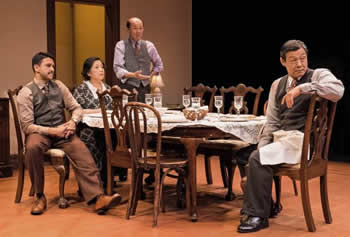HotReview.org Editor's
Picks
Shows Worth Seeing:

Awake and Sing!
By Clifford Odets
The Public Theatre
425 Lafayette St.
TICKETS
Who gets to decide what a representative American looks and sounds like? Prominent dramatists, painters, novelists, filmmakers, and politicians as well as powerful hatemongers have all weighed in, and the question remains as nettled as it ever was. Arthur Miller delighted some and offended others by deliberately muting the Jewish identity of his Loman family to make them seem more typically American in 1949. Clifford Odets made the opposite choice 14 years earlier in Awake and Sing!, audaciously investing his Berger family with the most specific New York Jewish features, including a very parochial way of speaking. No one had seen or heard people like these on a mainstream American stage before—realistic portraits of ordinary contemporary Jews—and in some circles the thrill of that cultural arrival lasted many years.
Eight decades later, the Berger family’s representativeness is easy to recognize but perhaps hard to savor in a way. The quintessentially American themes in Awake and Sing! are plainly evident—the collision of group and self-interest, the questioning of economic shibboleths during the Depression, the strains of assimilation and competing fears of war and isolation—but the play can unfortunately come off as a predictable period chestnut when revived (as it usually is) in the Group Theater’s transparently realistic style. We relish virtuosity in realism, but the truth is, it can be more numbing than thrilling. Having verified the accuracy of, say, the stage furniture, the actors’ accents, their costumes and hairstyles, our brains often go to sleep, fit for nothing but passively sipping nostalgia.
Thankfully that doesn’t happen in this marvelous NAATCO production directed by Stephen Brown-Fried, whose first-rate cast is Asian-American. The show is not explicitly Brechtian, but its brand of psychological realism has (possibly unintended) Brechtian flavors. The visual distance between the actors and their characters precludes passivity on our part by forcing us to see the play’s realistic details as artistic choices. In other words, a sort of sub rosa distancing effect arises simply because actors with Asian features are mimicking the idiosyncratic manners and verbiage of 1933 New York Jews we know they don't resemble. The mimicry is wonderfully adept, but the disparity in appearance opens up a crucial space for contemplation, making it easier to see the characters in general terms. This effect also strengthens the story’s emotional grip. The fate of Odets’s specific individuals comes to seem thrillingly aligned with that of uncountable others in every sectarian American category.
